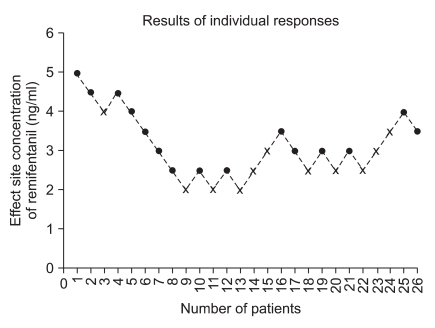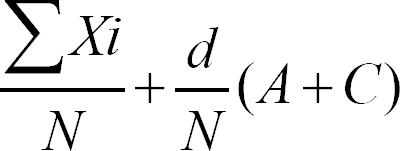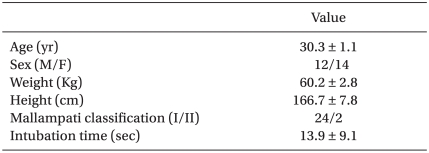1. Hassan HG, el-Sharkawy TY, Renck H, Mansour G, Fouda A. Hemodynamic and catecholamine responses to laryngoscopy with vs. without endotracheal intubation. Acta Anaesthesiol Scand. 1991; 35:442–447. PMID:
1887747.

2. Knight RG, Castro T, Rastrelli AJ, Maschke S, Scavone JA. Arterial blood pressure and heart rate response to lighted stylet or direct laryngoscopy for endotracheal intubation. Anesthesiology. 1988; 69:269–272. PMID:
3407977.

3. Yum KW, Oh YS, Oh SE. Comparative Study of Hemodynamic Changes and Complications following Lightwand of Laryngoscopic Intubation. Korean J Anesthesiol. 1995; 28:203–209.

4. Dixon WJ. The Up-And-Down Method For Small Samples. J Am Stat Assoc. 1965; 60:967–978.

5. Vuyk J, Engbers FH, Burm AG, Vletter AA, Griever GE, Olofsen E, et al. Pharmacodynamic interaction between propofol and alfentanil when given for induction of anesthesia. Anesthesiology. 1996; 84:288–299. PMID:
8602658.

6. Kil HY, Lee SI, Lee SJ, Lee SW, Lee DH. The bispectral index and modified observer's assessment of alertness/sedation scale comparable to effect site concentration of propofol in Koreans. Korean J Anesthesiol. 2000; 38:251–257.

7. Shinn HK, Lee HS, Lee CS, Chung CK, Cha DC, Kim HH, et al. The Effect-Site Concentration of Remifentanil for Prevention of Increase of Blood Pressure and Heart Rate to Tracheal Intubation during Propofol-Remifentanil Total Intravenous Anesthesia in Korean. Korean J Anesthesiol. 2006; 51:312–317.

8. Lee JH, Kim SI, Ok SY, Kim SC. Evaluation of effect-site concentration of remifentanil for blunting hemodynamic responses to endotracheal intubation during total intravenous anesthesia using propofol. Korean J Anesthesiol. 2007; 52:269–274.

9. Kim JY, Park SY, Moon BK, Kim DW, Kim JS. Predicted effect-site concentration of remifentanil for facilitating laryngeal mask airway insertion with propofol target-controlled infusion. Korean J Anesthesiol. 2007; 52:381–385.

10. Albertin A, Casati A, Federica L, Roberto V, Travaglini V, Bergonzi P, et al. The effect-site concentration of remifentanil blunting cardiovascular response to tracheal intubation and skin incision during bispectral index-guided propofol anesthesia. Anesth Analg. 2005; 101:125–130. PMID:
15976218.
11. Lee JH, Jeon WJ, Shim JH, Cho SY, Yeom JH, Shin WJ, et al. What is an optimal effect site concentration of remifentanil for minimizing the hemodynamic change to endotracheal intubation using light wand? Korean J Anesthesiol. 2007; 52:278–283.

12. Hwang JW, Noh GJ, Oh YS. Comparative study of light wand and direct laryngoscope: Correlation of time to intubation and thyromental distance, and change of blood pressure and heart rate after intubation. Korean J Anesthesiol. 1999; 36:949–954.

13. Lee HK, Yoo BH, Lee SS, Lim YH, Yon JH, Hong KH. Remifentanil effect-site concentration blunting cardiovascular responses to tracheal intubation for different sex during propofol infusion. Korean J Anesthesiol. 2007; 52:521–525.

14. Yoo BH, Lee S, Lee Y, Woo SH, Yon J, Hong K. The correlation between blood pressure elevation and intubation time during tracheal intubation using lightwand or direct laryngoscope. Korean J Anesthesiol. 2007; 52:S9–S13.

15. Nishikawa K, Omote K, Kawana S, Namiki A. A comparison of hemodynamic changes after endotracheal intubation by using the lightwand device and the laryngoscope in normotensive and hypertensive patients. Anesth Analg. 2000; 90:1203–1207. PMID:
10781480.

16. Wong SY, Coskunfirat ND, Hee HI, Li JY, Chen C, Tseng CH. Factors influencing time of intubation with a lightwand device in patients without known airway abnormality. J Clin Anesth. 2004; 16:326–331. PMID:
15374552.







 PDF
PDF Citation
Citation Print
Print




 XML Download
XML Download